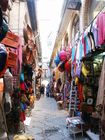
The Realejo, model of Granada's Jews.
The old Jewish quarter of El Realejo is the protagonist of this route which uncovers for the traveller the following landmarks: Plaza del Padre Suarez (Casa de los Tiros and ex convent of San Francisco Casa Grande); Juderia; Comendadoras De Santiago; Santa Cruz la Real; Calle de San Matias (Casa del Gran Capitan and Church of San Matias); Castle (former barracks) and the gate of Bibataubín (present council offices). On the second of January 1492 the Catholic Kings enter Granada putting an end to almost eight centuries of Islamic occupation in the Peninsula. With Christian domination the city gives birth to a new era of splendour. In this first period, of the Catholic Monarchs, are erected the great Christian monuments in late Gothic style, now that Granada was seen as a symbol: apart from the distances, it was the new Jerusalem reconquered. For this reason, the concern of the crown was the repopulation and the ennoblement of the former capital of the Nazarene kingdom. Before the Christian conquest, the jews had their citadel on the left bank of the Darro. The city was identified with them to such an extent that the Moors called it "Garnata al-Yahud" or Jewish Granada. When the Christians took the city they raised the quarter to the ground and renamed it El Realejo, the name by which it is known today since it had been appropriated by the crown. One of the most important spaces of the quarter is the splendid Campo de Principe created by the Catholic Kings to mark the marriage celebrations of their son Juan and over which soars up the church of San Cecilio constructed at the beginning of the fifteenth century.
| 



 Ayuntamiento de Granada
Ayuntamiento de Granada

